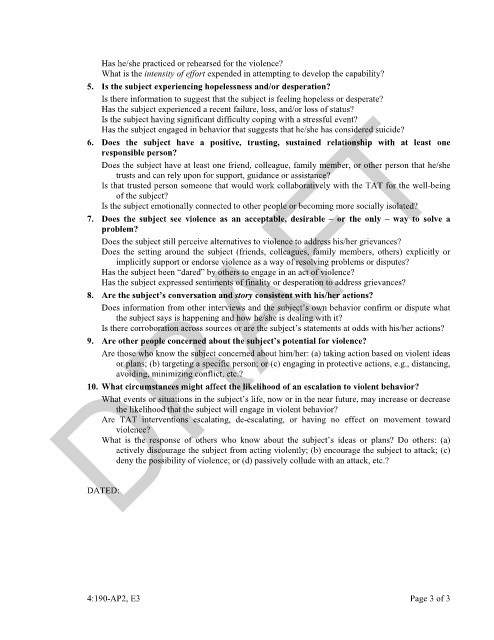Page 881 - draft
P. 881
Has he/she practiced or rehearsed for the violence?
What is the intensity of effort expended in attempting to develop the capability?
5. Is the subject experiencing hopelessness and/or desperation?
Is there information to suggest that the subject is feeling hopeless or desperate?
DRAFT
Has the subject experienced a recent failure, loss, and/or loss of status?
Is the subject having significant difficulty coping with a stressful event?
Has the subject engaged in behavior that suggests that he/she has considered suicide?
6. Does the subject have a positive, trusting, sustained relationship with at least one
responsible person?
Does the subject have at least one friend, colleague, family member, or other person that he/she
trusts and can rely upon for support, guidance or assistance?
Is that trusted person someone that would work collaboratively with the TAT for the well-being
of the subject?
Is the subject emotionally connected to other people or becoming more socially isolated?
7. Does the subject see violence as an acceptable, desirable – or the only – way to solve a
problem?
Does the subject still perceive alternatives to violence to address his/her grievances?
Does the setting around the subject (friends, colleagues, family members, others) explicitly or
implicitly support or endorse violence as a way of resolving problems or disputes?
Has the subject been “dared” by others to engage in an act of violence?
Has the subject expressed sentiments of finality or desperation to address grievances?
8. Are the subject’s conversation and story consistent with his/her actions?
Does information from other interviews and the subject’s own behavior confirm or dispute what
the subject says is happening and how he/she is dealing with it?
Is there corroboration across sources or are the subject’s statements at odds with his/her actions?
9. Are other people concerned about the subject’s potential for violence?
Are those who know the subject concerned about him/her: (a) taking action based on violent ideas
or plans; (b) targeting a specific person; or (c) engaging in protective actions, e.g., distancing,
avoiding, minimizing conflict, etc.?
10. What circumstances might affect the likelihood of an escalation to violent behavior?
What events or situations in the subject’s life, now or in the near future, may increase or decrease
the likelihood that the subject will engage in violent behavior?
Are TAT interventions escalating, de-escalating, or having no effect on movement toward
violence?
What is the response of others who know about the subject’s ideas or plans? Do others: (a)
actively discourage the subject from acting violently; (b) encourage the subject to attack; (c)
deny the possibility of violence; or (d) passively collude with an attack, etc.?
DATED:
4:190-AP2, E3 Page 3 of 3

